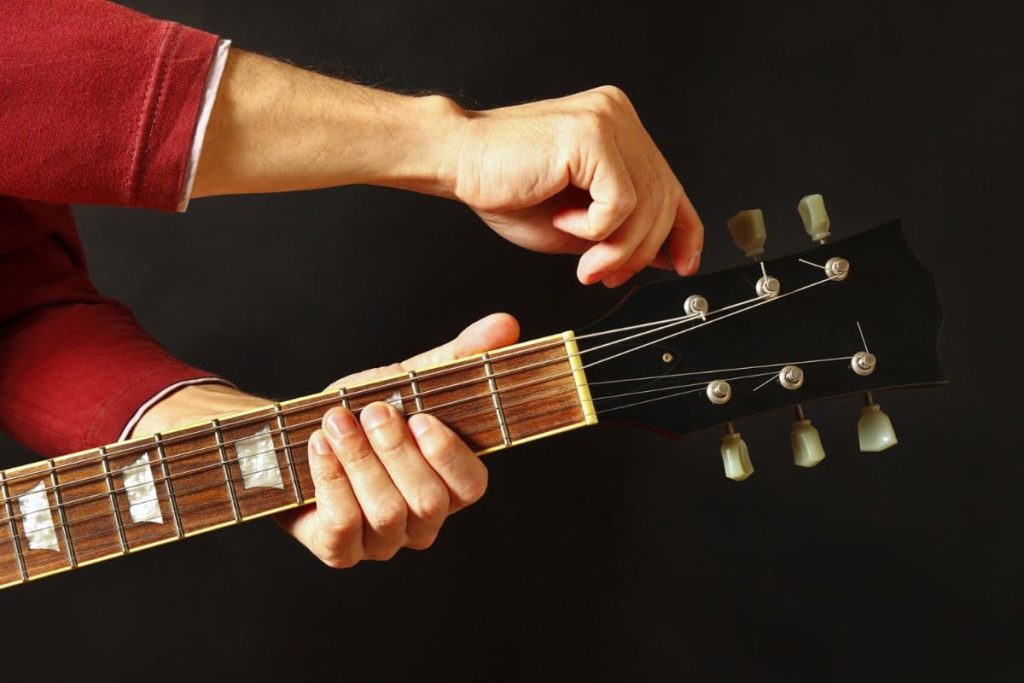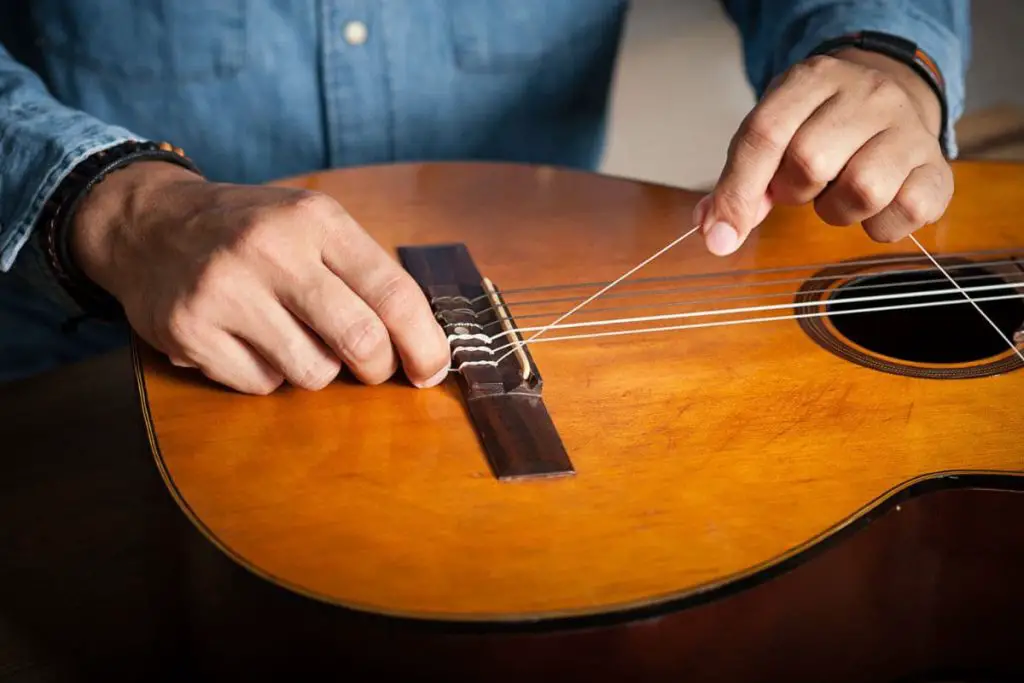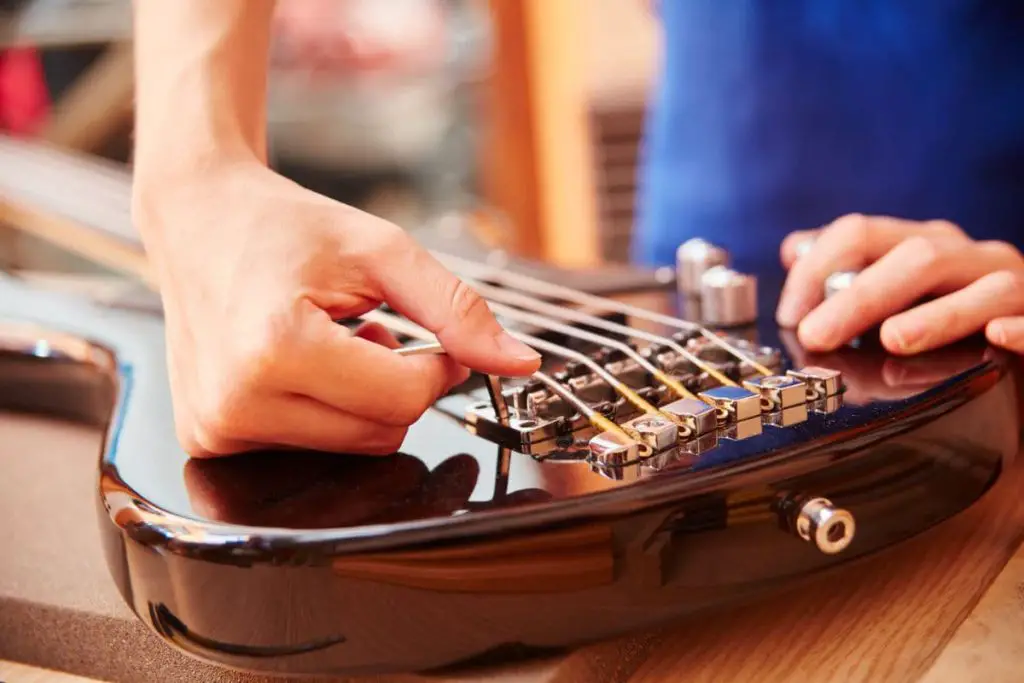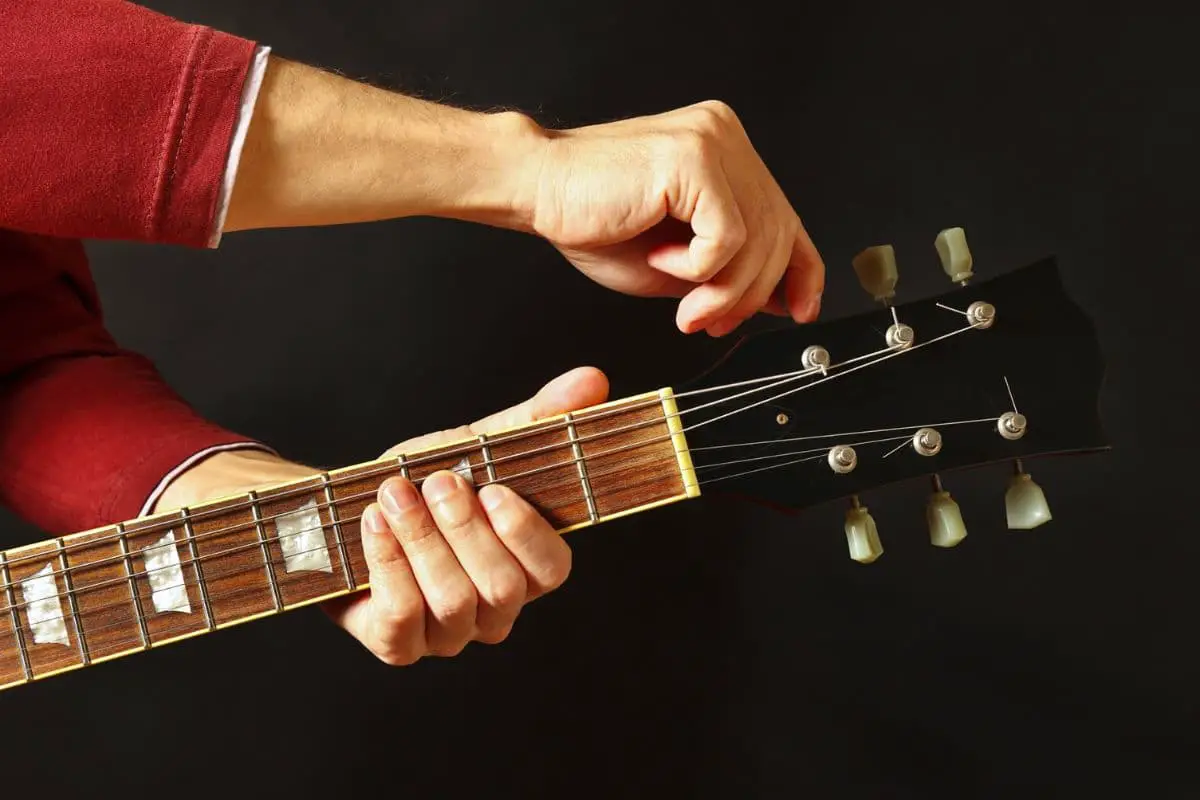Guitar strings break from old age, misuse, and tuning problems. However, you shouldn’t have to deal with broken strings every time you tune and adjust the guitar. Tuning is a regular part of playing this instrument, so important to know how to tune it and what you can do to avoid unwanted and unnecessary breakages.
To stop guitar strings from breaking while tuning, wrap the string ¾ of a turn around the tuning peg when stringing it. Make sure you file the frets and clean the bridge, nut, and tuning pegs every time you get new strings. Cleaning the strings will also prevent them from snapping while tuning.
In this article, we’ll explain how you can keep your guitar strings in good condition while tuning them. We’ll also dive into various maintenance suggestions to make sure your strings don’t snap for as long as possible.
If you want to find out what my recommended guitar gear is, then here is what I recommend on Amazon:
- Fender Cutaway Acoustic-Electric Guitar Bundle (MY FAVORITE GUITAR)
- Snark SN-8 Super Tight All Instrument Tuner (Easiest Tuner I’ve Used)
- 6 String Acoustic Guitar Capo (Best CAPO for quick changes)
- Dunlop Max Grip 1.0mm Nylon Picks (Thick Guitar Pick So You Don’t Lose Grip!)
- Universal Guitar Stand (Cheap & Minimalist Guitar Stand I Recommend)
- Levy’s 2″ Wide Quick Adjust Guitar Strap (Best Guitar Strap For Any Level)

String the Tuning Peg Properly
Stringing the tuning pegs incorrectly can result in premature breakages and unwanted stretching. It can also bend the tuning pegs, causing them to ruin the guitar’s tuning. When you string the tuning pegs, it’s important that you know which direction to go, how far past the peg the string needs to be, and which pegs each string goes to.
Here’s a detailed list of how to string the pegs properly to avoid tuning string breakages:
- Wrap the string ¾ of a turn outward around the tuning peg. Ernie Ball (one of the most popular guitar string manufacturers) suggests winding ¾ of a turn around the peg because it shifts the tension point. This method prevents the strings from compressing the nut and causing a weak spot.
- Pull the string at least an inch and a half through the peg before stringing it. Slide the string through the tuning peg, cut it 1.5 inches above the peg, then pull it back down. You can use the ¾ turn method with the top ½-inch of the string. Adding an inch and a half to two inches above the string prevents it from stretching too much.
- Always make sure the strings are on the inside of the tuning peg while being pulled outward. If the strings go outside of the pegs, they’ll put inward pressure on the pegs and cause them to break. This bending tension also loosens the peg screws and strips the headstock’s wood.
- Tighten the tuning pegs before and after stringing and tuning the guitar. The tuning pegs hold the strings, but they move a little bit when you string or tune the instrument. These slight movements will loosen the strings after a while, so it’s better to tighten the pegs to prevent them from happening.
Clean Your Guitar Strings Regularly
Cleaning your guitar strings will prevent wear and tear, rust, corrosion, and grime from ruining them. Furthermore, it’ll stop them from snapping every time you tune the guitar. Dirty strings are abrasive and weak, which means they’re much more likely to break when strumming, fingerpicking, stretching, bending, and more.

Try this simple guitar string cleaning method:
- Wipe the strings with a soft microfiber cloth. Microfiber won’t damage the strings because it’s non-abrasive. Some towels will leave cotton fibers, so make sure you remove them before playing the guitar. Gently wrap the cloth around one string, slide it down the string, then move to the next one.
- Use a guitar cleaning solution to clean all sides of the strings. Try the Ernie Ball Wonder Wipes (available on Amazon.com). These wipes pack a punch when it comes to removing the dirt and debris off of your guitar strings. Each pack contains 20 wipes, so you’ll have enough for many months to come.
- Let the strings air dry in a room temperature location. Don’t store the guitar in extreme temperatures or humidity because moisture and heat can ruin the wood and the strings. It’s important to let the strings dry before putting the guitar in its case; otherwise, they might develop rust and corrosion.
Never use citrus oils or anything other than chemicals designed for cleaning guitar strings. Many household chemicals can cause immediate damage to the strings. Furthermore, they can invite rust, corrosion, grime, and buildup.
It’s best to replace the strings if they look rusty or corroded. These strings can’t be cleaned, which means they’ll likely snap while you’re tuning them. You’ll also run the risk of cutting your fingers on rusty guitar strings, which could cause unwanted issues.
Maintain the Bridge, Nut, and Tuning Pegs
Maintaining every part of your guitar is essential, especially the parts that touch the strings. If anything damaged comes in contact with your guitar strings, it’ll ruin them. For example, an uneven bridge or nut could put too much tension on the strings. If the tuning pegs are warped or broken, they won’t secure the strings while tuning or playing.
Follow these quick guides to maintain each of these components:
Bridge Maintenance
To maintain the bridge of your guitar, wipe it with a microfiber cloth every time you remove the strings. Make sure the bridge is glued to the guitar if it came that way. Align the bridge in its slot, then string the guitar to prevent it from shifting. You can file each string slot on the bridge if they’re warped or scuffed.
Nut Maintenance
The nut sits at the opposite end of the bridge on the neck. It’s between the tuning pegs and the fretboard, which means it supports the strings at a very influential point. You can maintain the nut with the same suggestions as the bridge. Use a soft cloth, clean it with a guitar cleaning solution every time you remove the strings, and make sure it’s glued to the guitar.
Tuning Peg Maintenance
Maintaining your guitar’s tuning pegs is fairly straightforward. All you have to do is make sure you string the guitar correctly (as mentioned above) and tighten the mounting screws whenever they get loose. Use a soft cloth to remove oils and buildup, but don’t apply liquid since it could rust the screws and warp the wood.
Stretch Your Guitar Strings
Stretching your guitar strings will prevent them from snapping while tuning, strumming, and fingerpicking. Contrary to popular belief, stretching the strings adds strength to the guitar. This process ensures they won’t break due to minor stretches while tuning. It also lets you bend the strings much easier.

So, how do you stretch your guitar strings, so they don’t break when you tune them? Try the process below.
- Gently press the strings behind the nut. This area is the tightest part of the guitar strings. The tension builds from the tuning pegs to the nut. Lightly press them about ⅛ of an inch down, then release. Do this process for each of the strings until they feel a bit more flexible. You can do this every week or so if necessary.
- Hold the base of each string, then softly push the top of the string up and down. This step stretches the longest part of the string. Not only does it prevent the strings from snapping while you’re tuning them, but it also helps you slide, bend, pick, and strum the strings without worrying about them breaking.
- Tune the guitar, repeat steps 1 and 2, then tune it again. Stretching the strings will slightly change the guitar’s tuning. You’ll have to adjust each tuning peg after stretching them. It’s a good idea to stretch them two or three times, ensuring that you tune them between each stretching session.
Note: Don’t stretch the strings too hard. The last thing you want is to ruin a good set of strings. We highly recommend only stretching new strings or those in very good condition. Stretching old, worn strings is a surefire way to weaken or break them.
For a helpful video guide, review this YouTube tutorial of the method:
Tune the Guitar Slowly
There’s no rush to tune your guitar. You can break the nicest, most flexible strings available if you tune them too quickly. All guitar strings need to stretch a little bit during the tuning process. Moving too quickly or spinning the tuning pegs rapidly will break the strings or put unwanted strain on them that could cause problems later.
Get a Guitar Tuner
Guitar tuners help you prevent string breakages for many reasons. If you have a tuner, you don’t have to worry about tightening the strings too much. Additionally, tuners will let you know when you’re close to tuning the string or how far you’ve stretched it. For example, you can tighten a high E string until it’s a bit sharp, then lower it back to the perfect pitch.
The Fender FCT-2 Professional Tuner (available on Amazon.com) is a clip-on tool that shows you how to tune your guitar. The digital meter displays when it’s too sharp, flat, or perfect. Attach it to the headstock and pick each string while turning the tuning pegs until they’re all tuned. You can also use it for any other stringed instrument.

File the Fret Edges
Guitar frets are typically made of metal. They hold the strings when you compress them, allowing optimal pitch control. However, some frets get sharper than they should be. If a fret gets too sharp, it’ll scratch and corrode the strings. You can file these frets to reduce the chances of them damaging your guitar strings and fretboard.
Follow this fret filing method for the best results:
- Remove all of the strings from your guitar. Use a peg winder or your fingers to slowly loosen the strings. Many experts recommend removing two or three strings, replacing them, then moving to the next set. This method prevents too much tension loss on the neck, bridge, and nut.
- Get a fret filer. The FretGuru Fret Crowning File (available on Amazon.com) lets you reduce sharp edges and tall frets, easing the play style and reducing the chances of snapping a string. Glide this tool over the frets a few times for nearly instant results. You can also use fine sandpaper if necessary, but it won’t look as good.
- File the frets at the same angle they’re sitting. Most frets aren’t flat on the edges. The flat vertical edge would have corners that could scrape the strings every time you play a chord. They’re usually around 65-degree angles that need to be filed after long-term use. You’ll rarely have to file them, but it could be the reason all of your strings snap when tuning.
- String the guitar. Start with the bottom two or three strings, ensuring that you clean the bridge, nut, and fretboard before adding a new set of strings. Follow the aforementioned cleaning guidelines for the best results. Check the bridge and nut to make sure they’re tight and secure after adding each string.
- Tune the guitar. Tuning your guitar is a lot less intimidating when the strings don’t snap every time. You can do the most work on a guitar that doesn’t have strings because the components are revealed. Tune slowly, stretch the strings, then tune them again. Play a few chords, tune them again, and repeat until they’re good to go.
Filing your guitar frets can make a significant difference. Here’s a helpful YouTube breakdown of the process:
Adjust the Guitar’s Action
A guitar’s action is controlled by an adjustment nut that alters the truss rod. The truss rod runs through the guitar’s neck. If the truss rod is bowed or bent, it’ll stretch the strings. Tuning the strings on a bowed guitar will undoubtedly damage them. It could also break them when the truss rod goes back to normal, so it’s important to maintain the proper action.

If you don’t know how to adjust a guitar action, follow these instructions:
- Use an allen key or truss rod wrench to rotate the adjustment nut. The adjustment nut is typically located within the guitar’s body under the base of the fretboard. You’ll need the correct allen key, so measure the adjustment nut beforehand. While you can adjust the truss rod with the strings on the guitar, it’s easier to do so without them.
- Place the ruler on the neck and rotate the truss rod until the ruler is mostly flat against the fretboard. Most guitars can get close to flat. They don’t have to be completely flat, but it’s good to get as close as possible. A bowed guitar neck will snap the strings very often when you tune them.
- Tune the guitar after adjusting the action since it’ll throw the strings out of tune. Changing the action immediately stretches or loosens the strings. Either way, they need to be tuned quite a bit. If the strings stretch too much when you adjust the action, they might need to be replaced since they could snap.
Quick Tip: Always work in small increments. Turn the adjustment nut a short distance, check the neck, then repeat. If the action is misaligned or bowed, it’ll cause the strings to buzz and corrode. The strings shouldn’t be too hard to press against the fretboard. If they’re too high (over 2.8mm), the action or bridge needs to be lowered.
Get New Guitar Strings if Necessary
Unfortunately, old strings break. If you tuned your guitar and the strings broke, there might be nothing wrong with the guitar. Your strings should be replaced every few months, depending on how often you play the guitar. Your playstyle could also be a bit more intense than someone who does light fingerpicking.
Here’s how you can know if it’s time to replace your guitar strings to prevent them from snapping while tuning:
- If the strings are discolored and they don’t look normal after cleaning them, it’s time to replace them. Discolored strings are usually rusty, grimy, or corroded. They’ll break fairly quickly, especially since tuning them stretched them a little bit.
- When the strings can’t hold proper intonation, they might need to be replaced. Old strings stretch every time you tune them. Eventually, they won’t be able to hold the tuning for more than a few songs.
- Dry, rigid, or unwound strings should always be replaced. Low-quality strings lose their binding since they’re not made with the best materials. Look at the top four strings and make sure they’re in good condition from top to bottom before you play each time.
If other strings are snapping from the same pack, you might as well get a new set. Replacing your guitar strings regularly will prevent you from dealing with random breakages (Related: what to do if your guitar string breaks). A snapped string can strain the respective tuning peg, too. Choosing high-quality strings will make them last longer and stop them from snapping.
Final Thoughts
Guitar strings get old and could eventually snap. That being said, you shouldn’t have to think about them breaking every time you tune the guitar. Cleaning and maintaining the instrument is the best way to prevent this issue from happening. Don’t forget to stretch new strings and adjust the action as necessary.
If you want to find out what my recommended guitar gear is, then here is what I recommend on Amazon:
- Fender Cutaway Acoustic-Electric Guitar Bundle (MY FAVORITE GUITAR)
- Snark SN-8 Super Tight All Instrument Tuner (Easiest Tuner I’ve Used)
- 6 String Acoustic Guitar Capo (Best CAPO for quick changes)
- Dunlop Max Grip 1.0mm Nylon Picks (Thick Guitar Pick So You Don’t Lose Grip!)
- Universal Guitar Stand (Cheap & Minimalist Guitar Stand I Recommend)
- Levy’s 2″ Wide Quick Adjust Guitar Strap (Best Guitar Strap For Any Level)
Related Posts:
- Why Do Guitar Strings Have Different Thicknesses?
- How to Solo With an Acoustic Guitar (8 Easy Steps)
- 9 Ways to Make an Acoustic Guitar Quieter
- 20 Ways To Know if Your Guitar Is Acoustic or Classical
- 7 Steps to Making Your Acoustic Guitar Electric
- How To Play Guitar Without Looking (9 Training Methods)
- How To Keep a Guitar Strap From Falling Off (8 Ways)
- How To Fix a Loose or Broken Guitar Input Jack
- 11 Finger Stretching Exercises To Do Without a Guitar
- Guitar String Tension Calculator
- 10 Best Locking Tuners for Guitar (Buyer’s Guide)
- Best Electric Guitar Strings
- Best Guitar Strings for Telecaster
- Best Guitar Strings for Fender Stratocaster
- Best Guitar Strings for Country Music
- Best Guitar Strings for Les Paul
- Best Guitar Strings for Bending
- Best Guitar Strings for Blues

